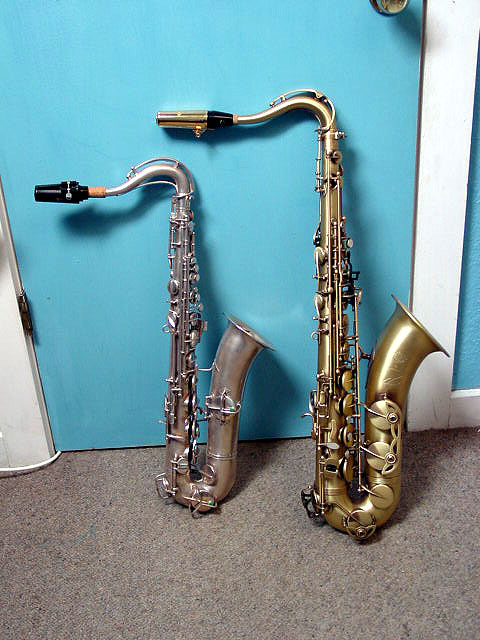Tenor saxophones in C and Bb. The Bb tenor is second in popularity only to the alto. It is perhaps THE quintessential jazz instrument, and it also has a vast amount of potential in the classical music arena, especially in the hands of such pioneers as James Houlik and John Moore. It is a very flexible solo instrument, and in a sax section or quartet, It's richly lyrical sound is a nice counterpart to the lighter sound of the alto. The C tenor has characteristic of tenor and alto- its bore is no larger than the alto's, yet is nearly as long as a tenor. Because of this, its sound is an exact halfway point between the Eb alto and Bb tenor. The C tenor is a member of Adolphe Sax's original orchestral set of saxophones, along with the F alto, C soprano, and so on. Most of these instruments never became widespread, since the saxophone wasn't accepted as a full-time member of the symphony orchestra. The Bb/Eb horns, intended for use in military and marching bands were fairly popular, so most of the rare orchestral parts that were written for saxophone used those instruments, since they were what was readily available. All this changed during the 1920's saxophone craze- This was a time when the recording industry was young, and most people made their own music. The C tenor (marketed as a "C-melody" sax), and to a lesser extent the C soprano, became hugely popular with amateur musicians because they could read melodies from vocal/piano/violin music without transposing. Two of the most popular saxophonists of the 1920's, Rudy Weidoft and Frankie Trumbauer, were C-Melody specialists. Young talent like Lester Young started their careers on C tenor. As Jazz became popular, however, and the Great Depression and growing recording industry decimated the home music market, the balance of popularity shifted back to the "professional" Bb and Eb instruments. Many, many thousands of C-Melody saxes were junked, pawned, and consigned to attics, and by the 1940's they were no longer being made. The C tenor has a bad reputation for being cheaply made and out of tune. Many of these instruments are professional horns, however, and most intonation problems stem from using incorrect modern alto or tenor mouthpieces. With the right mouthpiece (still available from JJ Babbitt, Bill Street, and often seen on eBay), a good C tenor is a wonderful instrument. Sound samples (Nocturne by Ivan Shekov): mp3 demo C Tenor sax (Shekov) 1.7MB mp3 demo Bb Tenor sax (Shekov) 1.5MB
All material © Jay Easton 2001-2006 unless otherwise noted
|


